The Last in Line
1.IntroThis Forum already have one fine review of the Shoei FG-42 model so I will try to avoid repeating too much, instead focus on the practical use of the real FG-42.
Yes military parachuting pioneered in late 1918. By 1935 Germany started forming Parachute units, that were given baptism of fire in the early campaigns of WWII. German equipment and deployment strategy resulted in the paratrooper been very lightly armed during launch and the additional need heavier equipment was launched separately.


Especially in the invasion of Crete (1941)this proves to be a dangerous strategy. As a consequence, the Luftwaffe requested a, new, selective-fire hand-held weapon for the paratroopers. Conflicting priorities with the Army resulted in HWaA dismissed the undertaking as unrealistic and offered their G 41(W) semi-automatic rifle instead) In the end Reichsmarschall Hermann Göring privately ordered the continuation of the project. and Luftwaffe went directly to German industry with its plans
Much information about the so-called LC-6 specification that resulted in the development and deployment of the FG-42 can be found on the internet so I will spare you the many details of history.
Result was that by 1943 the Krieghof factory delivered early type FG-42’s to Luftwaffe that hurried them into battle. Much is also written about reliability and success in battle, but it was for certain the first compact, full power cartridge, select fire weapon brought into the battlefield. Success and numbers produced were limited. Approximate 2000 were made by Krieghof before steel supply forced Krieghoff to make a major design change into the later type.
For this review I have studied the original German manual, so the following will contain guidance from the orginal technical manual and pictures of the Shoei model.
2.Box and contentThe box is straight forward cardboard, plain cardboard with a printing on the lid – Shoei logo and text naming the content.
Do please note that the original box also have the serial number of the model printed. I do not know other manufacturers that serialize their models, but Shoei models have individual numbers.
Inside the straight looking box is where the excitement start
Plastic bag and a lot of Styrofoam ! – obscures the quick glimpse but protects the model. I guess if you don’t like it, throw it away. I have kept all mine, I like my model and want to keep it safe.
But once full unwrapped the content is
• Model
• Magazine
• Box of dummy cartridges
• Instruction booklet
Shoei have made a new layout instruction, appearing much different than the previous issue. The new is a small booklet that includes both Japanese and English language variant.

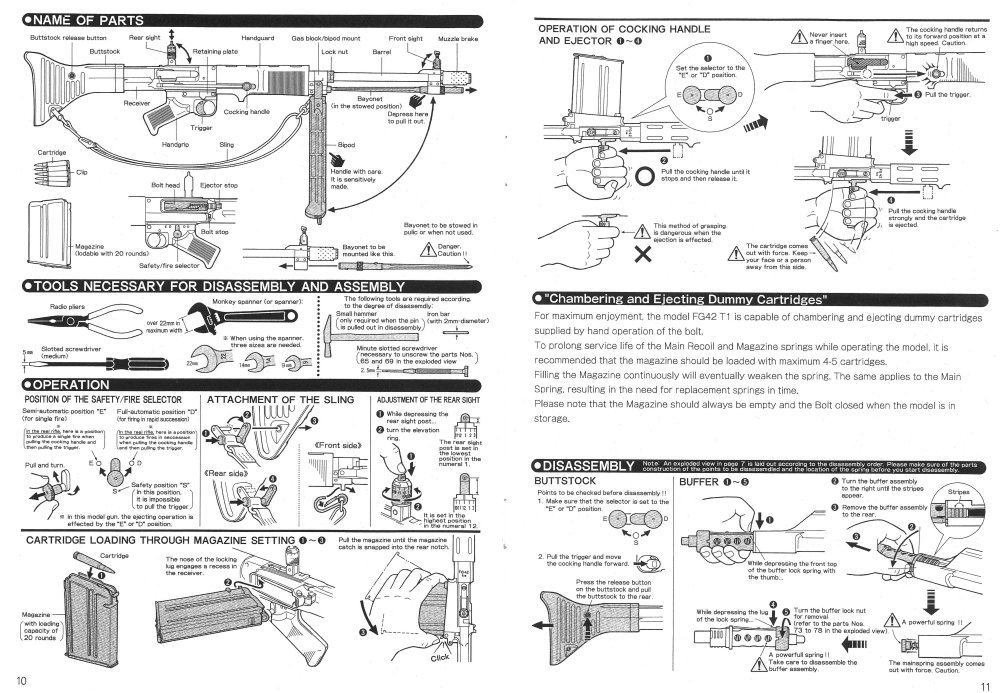


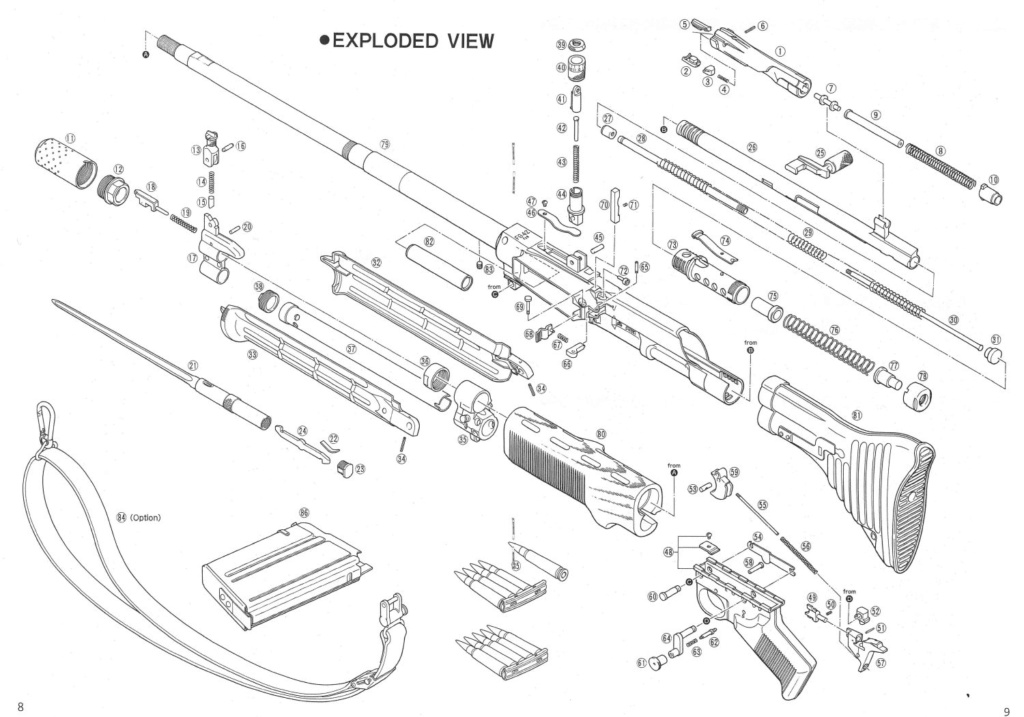
Comparing it to the original German issue instruction book its still a leaflet but is does cover the modelgun properly in 2 languages.
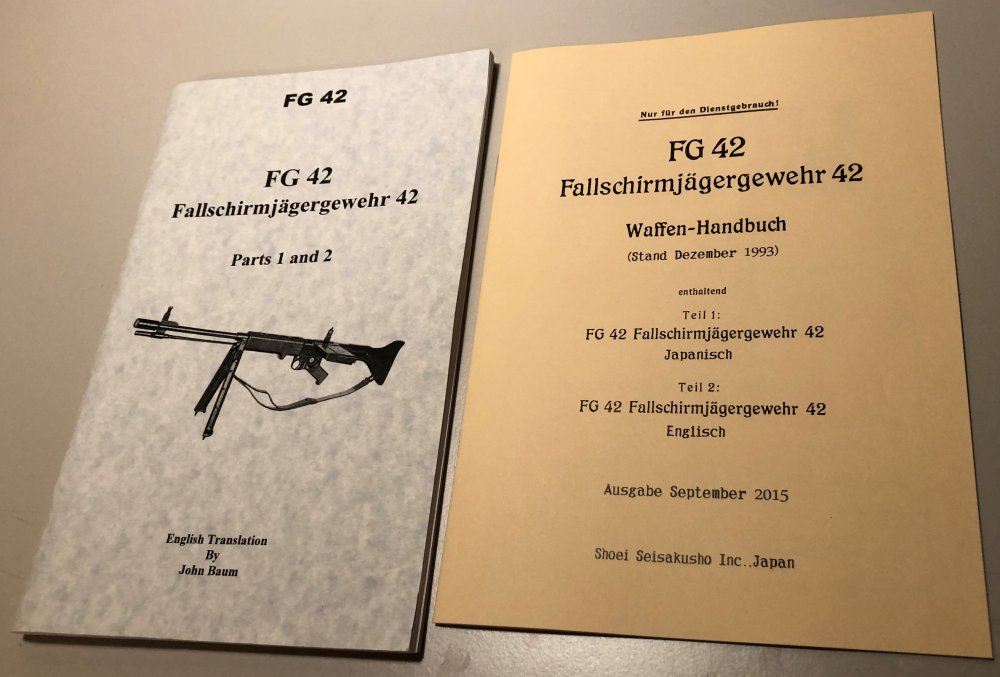 3.Look
3.LookFor the look of the box I guess it is an individual matter, but its basic and simple and well-functioning.

Appearance
There will be more pictures and I will comment in the last chapter on my feelings on appearance. But short it looks new and really nice.
4.Markingsbasic principles for proof marking of German handguns
Markings on FG42 Markings on model
In 5 positions
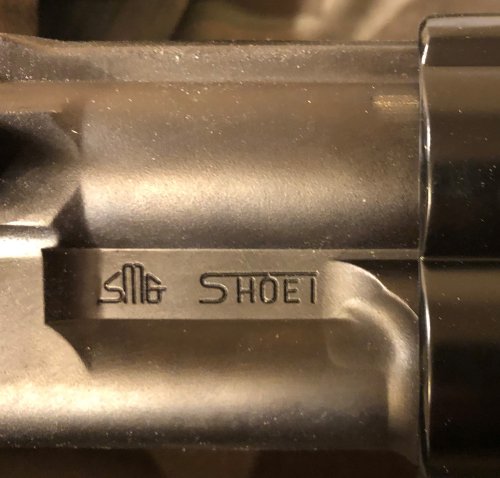
Shoei logo

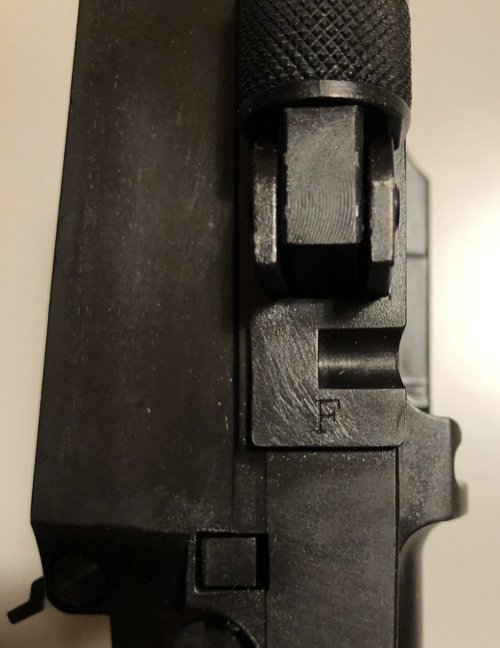
Type and serial F on the dovetail
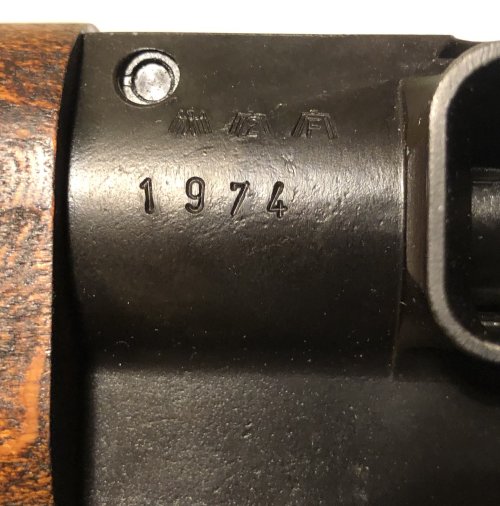
Proof marks and serial. Do note that Shoei serialize all their models individually so this model is number 1974 made at Shoei. Current production batch (2019) passed the magic number 2000 !

Fire mode settings
5.Technical datathe models have a very high dree of realism so let’s go through the technical function and data for the real gun.
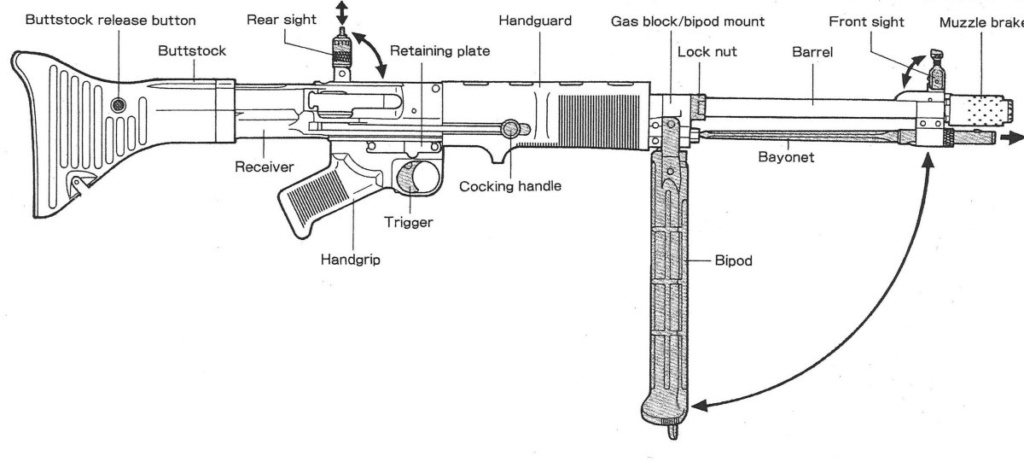
The FG 42 was a select-fire air-cooled weapon and one of the first to incorporate the "straight-line" recoil configuration. This layout, combined with the side magazine, placed both the center of gravity and the position of the shoulder stock nearly in line with the longitudinal axis of the bore, a feature increasing controllability during burst or automatic fire. The operating system was derived from that used in the successful Lewis light machine gun with a gas piston-actuated turning-bolt locking mechanism. This system used pressurized exhaust gases from the bore and channeled them through a port drilled in the barrel into a gas cylinder located under the barrel. The rapid build-up of propellant gases imparted rearward pressure on a long-stroke piston, driving it backwards, while an extension of the bolt carrier interacted with a helical camming slot machined into the bolt carrier, converting this linear movement into an angular velocity and forcing the bolt into a rotary motion, clearing the locking nuts and unlocking it near the end of the bolt carrier's travel. The weapon was locked into battery by two lugs on the bolt head which recessed into appropriate cavities machined into the receiver walls. Owing to its main intended use by paratroopers, the rear sight (which necessarily was rather high due to the straight stock design) was a flip-up construction. The iron sight line had a 530mm sight radius and consisted of an open-pointed-post-type front sight, and a diopter-type rear sight. It was graduated for 7.92×57mm Mauser cartridges from 100 to 1,200m in 100m increments. The top of the receiver of the FG 42 was specifically machined with a long dovetail type base designed to accept telescopic sight mounts. The scope mounts featured locking lever(s) that allowed quick installation and removal of a telescopic sight depending on the specific combat scenario; general combat or in a limited sniping role. The telescopic sights used on the FG 42 were the ZFG42 or ZF4.
When it comes to basic metrics it looks like this:

Shoei does not supply slings anymore but a sling can relatively easy be found at eBay or similar auctions. Bayonet is an integral part of the FG 42 design.
More on the technical path:
The receiver was a sophisticated, machined alloy forging with the magazine housing placed on the left-hand side and the ejection port on the right. Whilst not a true bullpup rifle design the seemingly awkward placement of the magazine housing (horizontally to the side rather than directly beneath the receiver) allowed the bolt mechanism to extend into the buttstock assembly, effectively reducing the overall length of the weapon as the magazine well did not interfere with the location of the pistol grip. The pistol grip was integrated into the trigger group assembly, a separate housing containing the trigger mechanism and fire control components and was formed from pressed sheet metal during fabrication from two separate halves and then welded together.
The FG 42 consists of 5 major groups - two moving and three stationary major parts.
A. Receiver with Barrel, stationary (yellow)
B. Grip, stationary (blue)
C. Base Piece, stationary (green)
D. Bolt, moving (red)
E. Buttstock, moving.(grey)
F. Magazine
6.Stripdown and servicingContinuing service and functional safety of the FG 42 is provided by proper maintenance. To this purpose, the continuous monitoring of the individual parts must occur.
Official instruction are as follows for cleaning
If the Weapon has not been shot, cleaning is limited to the removal of dirt, moisture, dust, etc. Thereby the Rifle will not be disassembled further than necessary for this cleaning. The inside of the Barrel must be cleaned and freshly oiled. (Pay attention to the cleanliness of the inside of the Bolt Head!) After each shooting, a major cleaning is to be performed, whereby special attention is directed to the Bolt, Buffer, and Gas Tube. All parts are meticulously cleaned and oiled. It is hereby to be inspected for breakages, wear, cracks, etc. If the present parts are defective, they must be replaced with new.
Official instruction for Overhaul by the Armory
After 5-6000 shots or with repeated stoppages, the Weapon is to be checked in the Armory. The causes of the stoppages are to be eliminated. The Barrel is measured, as well as the Recoil Spring, Firing Pin Spring, Bolt etc. for quality - the springs are also to be inspected for length. Those parts which are not to be disassembled for the major cleaning are to be inspected especially carefully. Riveted parts shall not be disassembled for the possibility of overhaul.
Disassembly of the Weapon into major parts groups
For disassembling the FG42, hold it in the left hand with the Muzzle away from yourself
1. Remove the Buttstock
1.1. Press on the Buttstock Button with the thumb of the right hand and thereby
1.2. Pull the Buffer stock to the rear

2. Remove the Buffer
2.1. Enfold the Buffer with the right hand, then press and hold the forward part of the Catch Spring for the Buffer with the thumb, thereby
2.2. Twist the Buffer to the right or the left, so it can be pulled off toward the rear
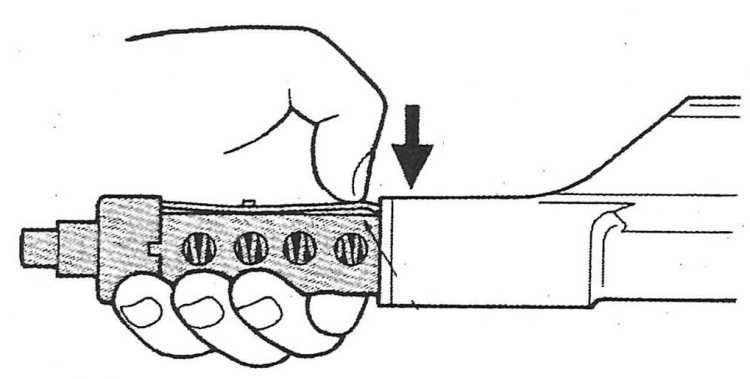
3. Take out the Bolt
3.1. Pull the Loading Grip to the rear to its stop
3.2. Remove the Recoil Spring with Guide Tube and Guide Rod

3.3. Take out the Loading Grip toward the right
3.4. Grasp the Bolt and Bolt Head and pull out toward the rear, thereby it is un cocked by a right twist.
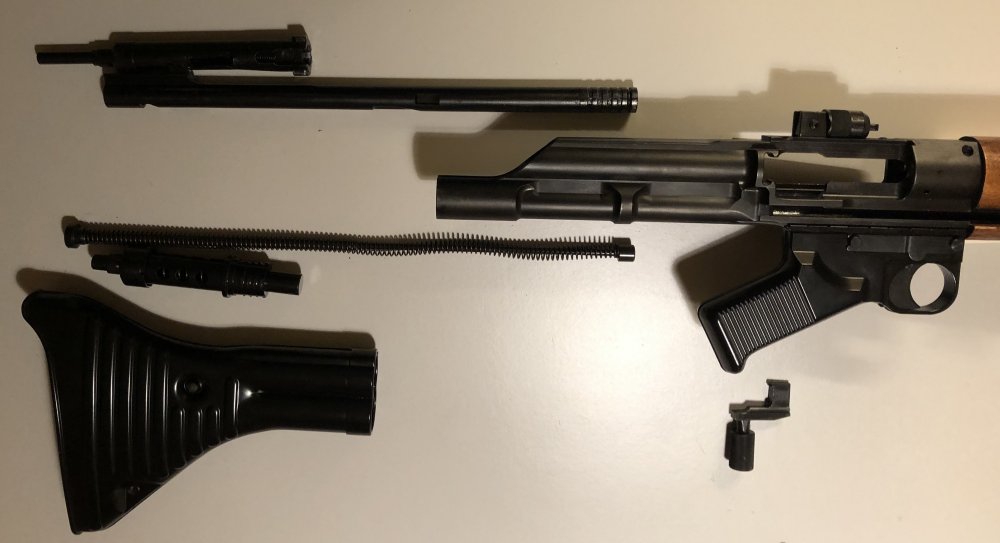
4. Take off the Grip
4.1. Remove the Bayonet by pressing in its Catch
4.2. Fold the Legs down, thereby the Closing Screw from the Bipod Mount lays free.
4.3. Take out the Closing Screw
4.3.1. Pull out the Gas Tube toward the front
4.4. Twist the Hand Guard on the Barrel toward the top so that the Grip is released
4.5. Press in the Leaf Spring for the Grip, twist downward and pull away toward the top
4.6. Loosen the Pin for the Grip
4.7. Shove the Grip from the Ledge of the Receiver a bit toward the front and take off toward the bottom.
5. Magazine is inserted by engaging the front lug inside the magazine well and pressing the rear part of magazine into the catch. Magazine is removed in a reverse movement
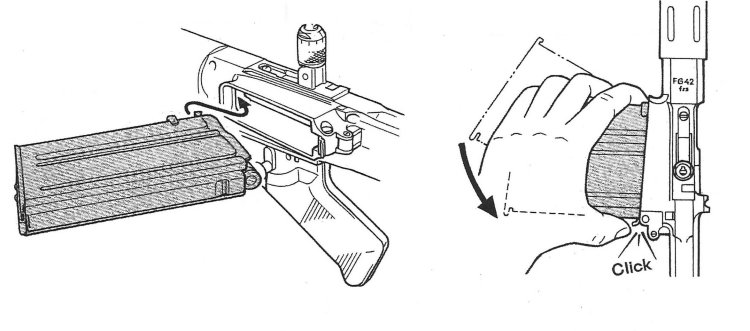
Assembly occurs logically in reverse order, thereby to be observed is:
1. When again guiding in the Gas Tube, its longer slot is to be aligned with the slot in the Receiver (Loading Grip Guide).
2. When guiding in the Bolt, cock the Bolt Head by pushing with a left twist and push in. Notice: When cocked, the Locking cams of the Bolt Head stand vertical!
7.Magazine & loadingFeeding of the original FG 42 occurred by a Magazine with either 10 or 20 Shots. The Magazine is a flat, double stack, Magazine. The FG42 could also be loaded via 5 shot clip/strips issued for the Kar98.

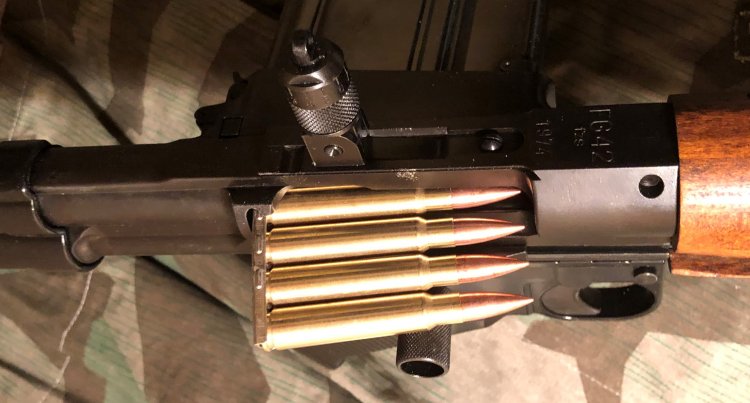
The FG42 was issued with M 20 Magazines (20 rounds) and the M10 was optional. Dimensions for M20-42 being 30x90x150mm and the M10-42 50mm shorter
Features of Magazine
The filling of the Magazine occurs by hand, whereby the Follower is shoved down by the Cartridge and the Magazine Spring is compressed. Due to the stepped upper surface of the Follower, the Cartridges lay in a zig-zag on top each other when filling. For shooting, the Magazine is hooked into the Magazine Well with the Nose and pushed toward the rear until the Magazine Catch engages. The Magazine Spring makes sure that one Cartridge always lays on the Magazine Lips. For shooting, this Cartridge is thrust by the bottom pressure of the Recoil Spring in front of the forward moving Bolt Head, which pushes it from the Magazine and into the Chamber of the Barrel. When the last Cartridge is loaded and the Magazine is empty, so pushes the Nose of the Follower against the Bolt Catch so that this enters into the Slot and the Bolt remains open.

For removing the Magazine, it is grasped by the left hand with the left thumb pushing the Magazine Catch toward the front, and the Magazine is taken out toward the left with a slight pivot forward.
Maintenance
The Magazine is to be kept clean. Foreign bodies are to be removed from the inside. Thereon is especially to be observed that the Magazine is not dent and the Magazine Lips are not bowed together.
8.Cartridges & fireTo my research Shoei have, long time ago made a PFC version of the FG42. It’s no longer available – most likely to difficulty with stable performance. SO this is the Dummy version and as such the cartridges are plaint dummies. Very good looking but no more.

At first glance the Shoei cartridges appear identical to the real thing but measuring out both reveals that neck and buller neck are slightly different. For me it still remains to test chamber an inert cartridge but there is a risk it will get squeede in the Shoei chamber so don’t just sam it inthere !
Sequence of Operation
Firing
The FG 42 fired in semi-automatic mode from a closed bolt, accomplished by delaying the release of the firing pin (mounted on the bolt carrier and released by the front sear notch) until after the trigger had been pressed; the short lock time, and little movement in the action during firing translated into greater single-shot accuracy. When operating in the automatic mode, the sear mechanism was designed to fire from an open bolt by simultaneously releasing both the bolt and bolt carrier. This had the advantage of preventing a phenomenon known as "cook off" where the heat of repeated rounds being fired caused a chambered round to overheat and prematurely ignite the powder or primer. With automatic fire selected, the bolt would remain open between bursts to provide maximum cooling. The rotating fire selector switch was situated in the trigger group, above the pistol grip on the right side. The charge lever also served as the safety, disabling the sear mechanism when engaged.
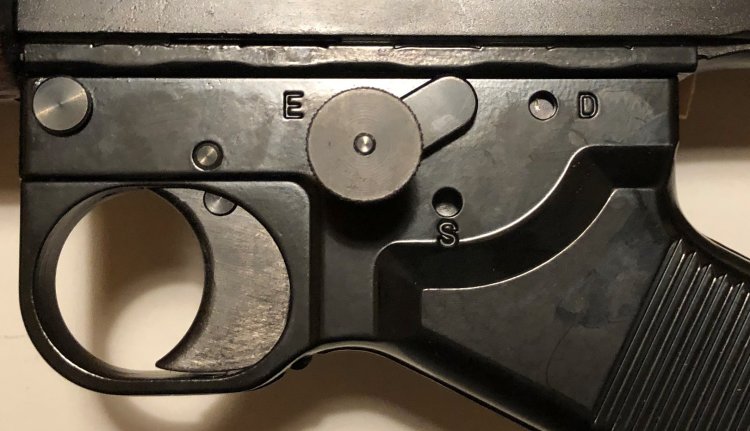
Single Fire
The Safety is set on "E": Einzelfeuer (Single Fire). In this position, the Safety Pin rotates the Trigger Lever with its Catch Nose on the Mount toward the left. The Catch Nose of the Trigger Lever can now only jump into the cutout for Single Fire of the Bolt Guide Piece. At the rotation of the Trigger Lever on the Mount, the Disconnector lays with its lower edge on the Trigger, while its upper ledge lays within the path of the Bolt Guide Piece. The Bolt stands toward the front and is locked.
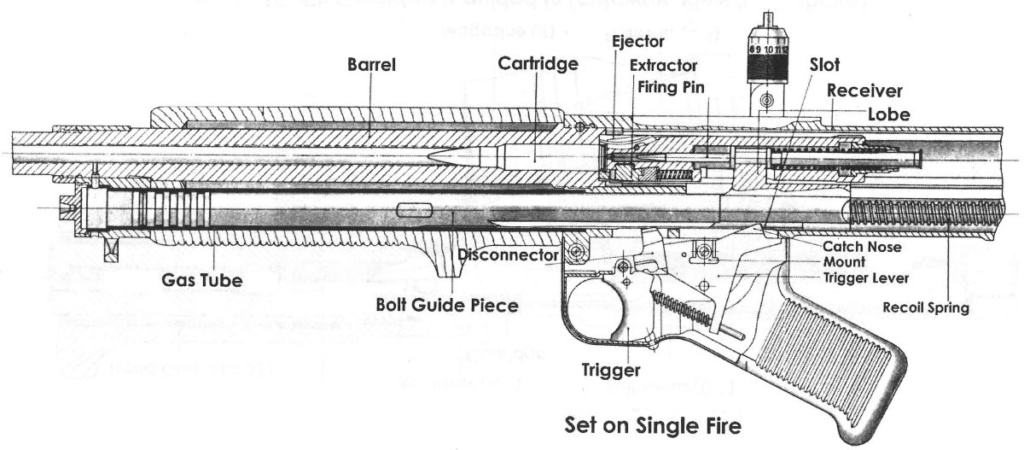
After the Shot has passed the Gas Port of the Barrel, some of the Powder Gas goes through this Port to the abutting face of the Bolt Guide Piece and propels it rearward. Thereby the Recoil and Firing Pin Springs are compressed and the Bolt Head in its curved Slot is unlocked by the Lobe of the Bolt Guide Piece. The Shell is pulled to the rear by the Extractor. With further recoil, the Ejector is pushed forward by the Ejector Strike. Its lower part glides from the rest of the Trigger, and the Trigger Lever with its Catch Nose kicks into the path of the Bolt Guide Piece. The Bolt Guide Piece is now again caught. The Trigger must be released before the firing of the next shot.
Automatic Fire
For automatic fire, the Safety is set on "D": Dauerfeuer (Burst fire). In this position, the Safety Pin rotates the Trigger Lever with its Catch Nose on the Mount toward the right. Thereby the Catch Nose of the Trigger Lever can only jump into the Slot for automatic fire of the Bolt Guide Piece. By the pivoting of the Trigger Lever, the Disconnector constantly on it and will no longer be deflected by the Guide Piece.

At the finish of loading, the Bolt with its Slot is caught by the Catch Nose of the Trigger Lever. If the Trigger is pulled now, so the Bolt runs forward, thereby a Cartridge from the Magazine is thrust into the Chamber of the Barrel by the Abutting Face of the Bolt Head, the locking of the Bolt Head with the Barrel occurs, and the Cartridge is ignited. Once the Shot passes the Gas Port of the Barrel, the powder gas streams in front of the abutting face of the Bolt Guide Piece and propels the Bolt rearward. Thereby the Recoil Spring and Firing Pin Spring are compressed. The Bolt Head with its curved slot is unlocked by the Lobe of the Bolt Guide Piece, whereby the Firing Pin retracts from the Hole of the Abutting Face. The Shell is carried rearward by the Extractor and by the kick of the Ejector against the Ejector Strike, it is tilted to the right and thrown out from the Extractor. So long as the Trigger remains pulled, the Bolt will not be caught, but rather run again forward over the action by the fully compressed Recoil Spring after each shot.
Operation of the Buffer and Buttstock
The Buffer is arranged to keep the Weapons recoil from the shot to a minimum. The dampening of the recoil force occurs by the Buffer Spring in the Buffer.
Safing the Weapon
When the Safety is set on "S", the Safety pin jumps in the Hole of the Trigger Lever and so prevents any movement of the Trigger.
Handling
Preparing the Weapon for Shooting.
The FG 42 is to be properly inspected for its function and the Bolt especially well oiled (Weapons Oil, blue). The motion of the Trigger is to be checked repeatedly at the same time, however without an inserted Magazine to finish loading. Never fire empty! {Never dry fire!}. Thereafter, a filled Magazine is held in the left hand and inserted with the Nose hooked in at the front of the Magazine Well, while the Magazine is pivoted rearward until the Magazine Catch clicks in. After setting on Single or Automatic fire, it will be finished loading and then safed.
While Shooting
For single fire, the Trigger is released after each shot! For automatic fire, the Weapon shoots so long as the Trigger remains pulled and a Cartridge is found in the Magazine. If the Magazine is shot empty, it is replaced with a filled Magazine and the Bolt pulled shortly rearward by its Loading Grip, whereupon the Bolt goes forward for single fire, or remains open for automatic fire. The Weapon is now again ready to fire. The Weapon can also be shot with the Bayonet extended.
After Shooting
Remove the Magazine. Unload the Weapon, then pull back the Bolt and while pulling the Trigger, slowly release the Bolt toward the front.
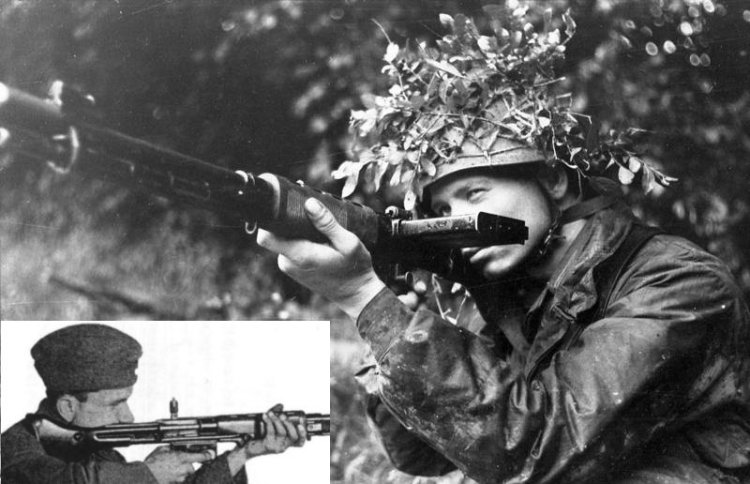
In general its worth mentioning the FG-42 must be considered a right hand shooter only weapon. The front grip can only be held safely with left hand, else interfering with the RH side moving bolt handle
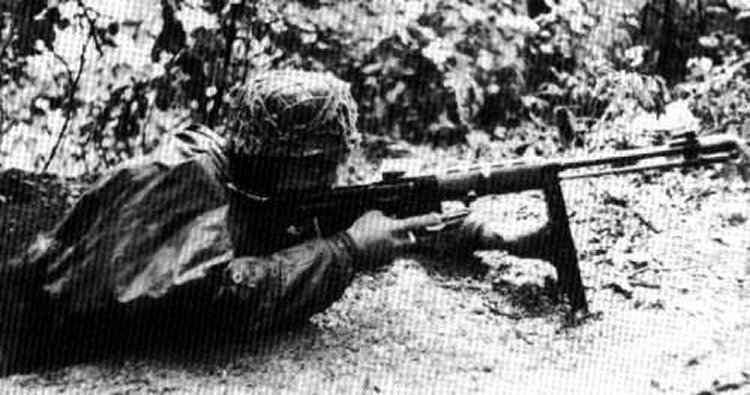
For shooting supported by the bipod most shooters preferred holding back one bipod leg to ensure safe support.
9.ConclusionFor me the FG42 is a very important technical milestone. Despite the performance challenges it was pioneering solutions and the role of the infantryman’s role on the battle field. Several of the solutions in the FG42 can bee seen in later infantry rifles. Also the concept of a full auto option to bring a light weapon with fast rate fire into the frontline.
The box for the model might look basic but it served the basic function very well – after all I didn’t buy the box I bought the model.

For the look of the model. Finish and surfaces are superb - -deep black and shiny new. When it comes to the appearance of an FG42 I feel it might appear small and fragile, on the other hand the intent with this weapon was to create a light auto fire handgun. In my opinion it also has a futuristic look that does appeal to me.
I understand with Shoei are marking with their logo – else I find the marking both nice, crisp and very realistic.
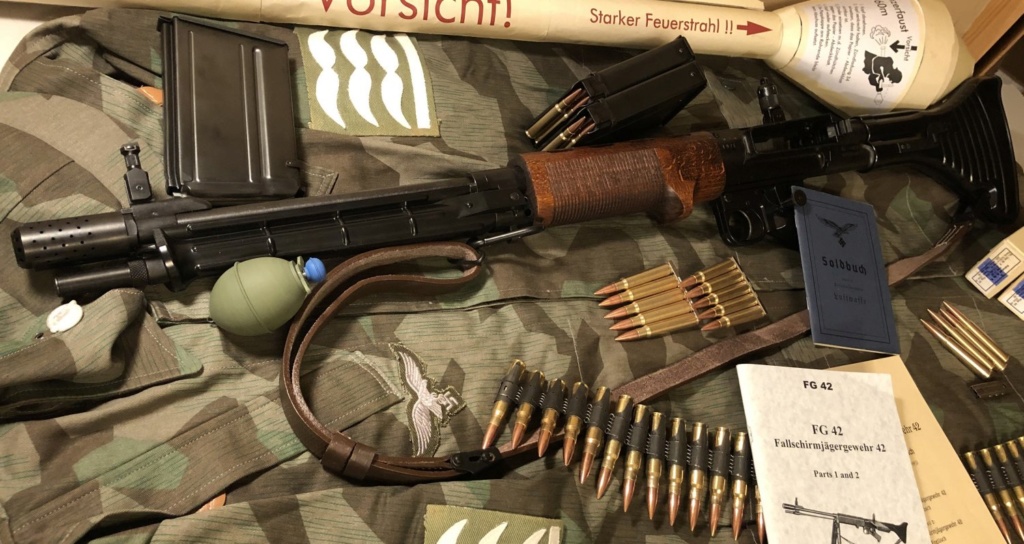
Comparing the model to real gun data is certainly impressive – it matches so fine. Most impressive I must say is after all holding the thing. IT IS HEAVY and cold it feels so real
Stripping is a true joy, metal parts all over – no wobbling plastic. Just remember it’s not steel, be gentle with it – but ok who wouldn’t be gentle at that price

I have to admit I am a great fan of PFC’s that auto fire and the Shoei model cannot honor that. That being said stripping handling cycling is a dream.
Having commented on my preferences for PFC the Shoei dummy cartridges are nice, realistic and comes in very very fine cardboard boxes.
According to my research Krieghoff manufactured approximately 2000 Early type FG-42 so this model beeing Shoei serialnumber 1974 must make it one of the last in line.
Many comment on the cost of a Shoei model, yes its true is an expensive model. I have been saving up and fortunate to be have the funding at the time Shoei produced the FG42. I guess all I can say is quality doesn’t come cheap – in my opinion Shoei is quality.
For sure I have checkked it into my Soldboch
last addition - last in line from Shoei

